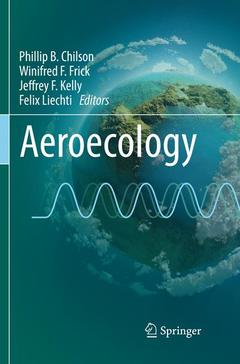Aeroecology, Softcover reprint of the original 1st ed. 2017

Prologue/Foreword.- Background.- Chapter 1: A tutorial treatment of the boundary layer and lower free atmosphere.- Chapter 2: A general treatment on how air is habitat to a host of diverse species.- Chapter 3: Coupling of weather and biology, including impacts of weather on biological behavior.- Chapter 4: Flight physiology (insects, birds and bats).- Chapter 5: Navigation / Orientation (insects, birds and bats).- Chapter 6: Fundamentals of migration.- Chapter 7: A broader treatment of entomology in the context of aeroecology along with methods of observing and furthering our understanding of insects.- Mehtods of Observation.- Chapter 8: Historical overview of methodologies, field observations, banding acoustics, other methods.- Chapter 9: Overview of the central questions related to monitoring the movements of individuals and why a deeper and more exact understanding of animal behavior at the individual level .- Chapter 10: Discussion of why thermal imaging techniques are needed and being used to track individuals and ensembles of individuals. Provide an overview of thermal imaging techniques for biological studies and how computer science is helping to visualize and model the results. Computer visualization of thermal data of bats.- Chapter 11: Transition from individual behavior to group behavior.- Chapter 12: Aeroecology and recent technological developments, ability to process, mosaick, and represent huge amounts of weather radar data in real time and create archives, resulting products represent for meteorologists and biologists, implementation of the Buler & Diehl algorithm, the prospects of Level III biological products.- Aeroecological case studies/Applications.- Chapter 13: Stop-over behavior of birds (and bats) and issues pertaining to land use.- Chapter 14: Linking population ecology to aeroecology.- Chapter 15: A general treatment of phenology and its significance.- Chapter 16: Aerosphere as a network connector.- Chapter 17: Interaction with human activities. An overview of aeroecological impacts: wind power, disease (if here then remove from chapter above and vice versa), aviation safety (aircraft / bird collisions), ecosystem services.
Dr. Winifred Frick is the Senior Director of Conservation Science at Bat Conservation International and adjunct faculty in Ecology and Evolutionary Biology at the University of California Santa Cruz. She received a B.A. in Environmental Studies from UC Santa Cruz and a Ph.D. at Oregon State University. Her research focuses on understanding how bat populations respond to natural and anthropogenic stressors and how science can be used to inform conservation decisions. She currently leads BCI's conservation science department and directs global bat conservation initiatives that target reducing threats and protecting globally endangered bats through research innovation and increasing capacity and local stakeholder involvement in conservation.
Dr. Jeffrey Kelly is the Director of the Oklahoma Biological Survey and a Professor of Biology at the University of Oklahoma. He received a BS in Wildlife Management from the University of Maine, an MS in Zoology from Oklahoma State University, and a PhD in Biology from Colorado State University. Dr. Kelly’s current research focuses on migratory macrosystems and interdisciplinary studies of human-wildlife conflicts in the lower atmosphere that emerge from rapid growth of telecommunicatio
Maximizes readers insights into the emerging scientific discipline Aeroecology
Highlights several existing and emerging technologies used to promote aeroecological studies
Frames some of the fundamental biological questions that can be addressed within the context of aeroecology
Date de parution : 12-2018
Ouvrage de 497 p.
15.5x23.5 cm
Date de parution : 04-2018
Ouvrage de 497 p.
15.5x23.5 cm



